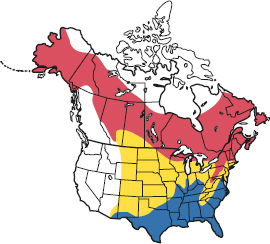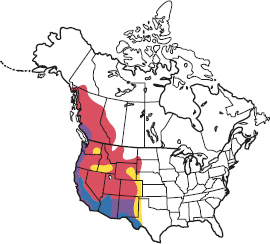Setophaga coronata

Audubon’s Warbler, female
All Yellow-rumped Warblers have a yellow rump (a feature also seen in Magnolia and Cape May warblers) and a yellow flank patch. The sexes are dissimilar and the male’s breeding plumage varies significantly across its range. Northern and eastern populations are called “Myrtle Warblers,” while western populations are referred to as “Audubon’s Warblers.” A summer adult male Myrtle has mostly blue-gray upperparts, streaked on the back, with two white wingbars and a yellow crown stripe. The head is dark but with a thin white supercilium and white throat. The otherwise white underparts have a dark breast band and dark streaks on the flanks. A male Audubon’s is similar, but the throat is yellow and the white color on the wings is more extensive. A summer adult female Myrtle has brown upperparts, an indistinct yellow crown patch, two faint wingbars, a white throat, and otherwise streaked white underparts. A female Audubon’s is similar, but grayer overall and with a yellow-flushed throat. Fall adults are duller than their summer counterparts. Immatures are like their respective fall females but warmer buff overall and without a crown patch; the throat is buff in Audubon’s but white in Myrtle, and the latter also has a thin, pale supercilium.
The Yellow-rumped Warbler is present as a breeding species across northern and northwestern North America mainly from May to August. Birds migrate south in fall, with the winter range extending from southern U.S.A. to Central America.

Audubon’s Warbler, male

Myrtle Warbler, female

Myrtle Warbler, male
FACT FILE
LENGTH 5.25 in (13.5 cm)
FOOD Invertebrates and berries
HABITAT Boreal forests, and montane conifer and mixed forests farther south
STATUS Widespread and common summer visitor; widespread in winter in the south
VOICE Song is a series of whistled trills. Call is a soft chep or chik
![]()

Myrtle Warbler

Audubon’s Warbler